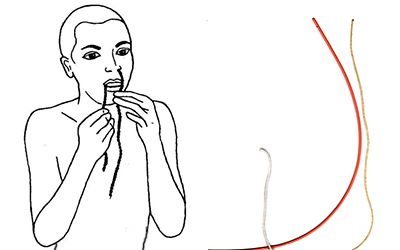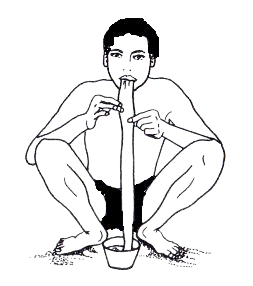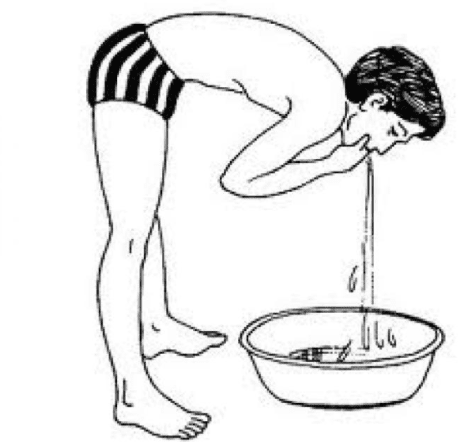
by Yoga In Nepal | Apr 5, 2021 | satkarma
Jala neti- nasal cleansing
We understand that yoga has numerous benefits. It not only strengthens the body but maintains a certain equilibrium that keeps the body in harmony. With that in mind, let’s shed some insight on some yogic techniques that aid in combating ailments. One of such methods that makes the body disease-free, is Jala neti. If you are wondering what it is, then do read this blog.
1. WHAT IS JALA NETI
The practice of Jala neti dates back hundreds of years. Initially, it was used by yogis to remain in top shape and free from diseases. This exercise deals with nasal hygiene and does the activity of cleaning the nasal passage. As brushing deals with dental hygiene, in the same way, Jala neti deals with nasal hygiene.
If we were to flip the ancient texts and manuscripts, we can find the references of Jala neti in the Hatha yoga Pradeepika. This textbook would be crucial for people that wish to study the quintessential Hatha yoga. Furthermore, Jala neti is also a part of the 6 purification methods, commonly known as ‘Shatkarma’.
2. PREPARATIONS FOR JALA NETI
If you are someone that has been practicing yoga for a while, then you are familiar with that yoga is simple. You don’t need many accessories to perfect it. All you need is courage and willpower. Likewise, when you are practicing Jal neti, you’ll need a pinch of salt, lukewarm water, and a small neti pot. For those that don’t know what neti pot is, it is a small pot with a long spout. The sprout is small enough to insert in your nostril.
3. PERFORMING JALA NETI
To perform Jala neti, the nozzle of the pot should fit carefully into your nostril. Make sure that the water does not leak out. The water should be at body temperature and mix a little bit of salt in it. If you experience pain, then seek medical aid.
Step 1: Washing the nostrils
- Fill the pot with saltwater and stand straight with the legs apart. Lean forward and close your eyes.
- Tilt the head to one side and raise your chin slowly.
- Inhale through your mouth and insert the nozzle inside the upper nostril.
- Firmly press the nozzle of the port in the nostril.
- Place the pot in such a manner that the water goes in your nostril and not on the face.
- Remove the pot and let the rest of the water run out of both nostrils.
- Tilt your head on the other side and repeat the entire process.
Step 2: Drying the nostrils
Let’s take a look at the second step of Jala neti which is drying the nostrils.
- Stand straight and close your right nostril with your right thumb. Inhale and exhale through the left nostril at least 5-10 times rapidly. Repeat this process on the next nostril too.
- Stand firm and then bend horizontally forward from the waist. Close the right nostril and bend the head to the right and inhale and exhale from the left nostril 5-10 times quickly. Repeat the process on the next side and end it by placing the head in the center.
- Stand firm with your feet apart. Close the right nostril and exhale vigorously while bending forward. Come back to your normal position and breathe normally. Continue this process 5-10 times. Finish this process by opening both your nostrils.
5. PRECAUTIONS FOR JALA NETI
While Jala neti is an exercise that provides unparalleled benefits, there are some key points that you need to consider. Such points are given below;
- People that suffer from high blood pressure should refrain from performing this exercise.
- If you feel dizzy when drying the nose, then do it slowly and in an upright position.
- Make sure that you don’t leave any water in the nasal passage as it might be prone to infection.
- Before you practice it by yourself, learn it from an expert.
Thus, these are the things that you should know while practicing Jala neti. We hope that you will implement these ideas and enjoy a healthy life.
You may like: Vamana Kriya one of the sat karma process

by Yoga In Nepal | Mar 26, 2021 | satkarma
Sutra Neti -A Yogic Detox Process
Yoga comprises numerous health techniques that are useful in living a healthy life. One of such practices that people can practice to live a fulfilling life is sutra neti. This wonderful technique dates back hundreds of years and although it saw some changes, the core idea remains the same. In this blog, we shall decipher the benefits, precautions, and how to practice sutra neti.
1. WHAT IS SUTRA NETI
It is an ancient yogic practice that is designed to cleanse the nasal cavity. It is one of the six methods of body purification as stated in the ‘Hatha Yoga Pradeepika’, a yogic text. This yogic text not only deals with sutra neti, but mentions other cleansing methods like Jala neti, and dughda neti.
Likewise, we can say that sutra neti is a method to clean the nasal passage. Its importance lies in the fact that it enables easy breathing, and accentuates asanas and pranayama. So, if you face any difficulties while performing these exercises, then do practice sutra neti.
2. WHAT HAPPENS IN SUTRA NETI?
To perform sutra neti, you need a waxed cotton string. This waxed cotton string goes through the nose and is taken out from the mouth. Grab both ends of the string with your hands and move it back and fro. This forward and backward motion cleans the nasal passage and enables you to breathe easy. In recent times, a rubber catheter is also frequently used.
3. HOW DO I PERFORM SUTRA NETI?
If you are a beginner, then you need proper guidance to perform sutra neti. Without proper guidance, you risk injuring yourself. You should perform this exercise early in the morning. The best time according to experts, is at the same time when you brush your teeth. Once you acquire a perfect rubber catheter, follow the given steps.
- Grab the rubber catheter with both your hands and slowly insert it into your left nostril. Make sure that you do not rush. As you move deeper, you can feel a tingly sensation. For some people, this sensation might be irritable. If you feel extreme irritation, then refrain from practicing and seek medical/expert guidance. Move the tube upwards into your nostrils and push it until it hits the back of the throat. At this point, the tube will now bend and move down to the throat. Slowly push the catheter down.
- In the third step of sutra neti, widen your mouth and use your fingers to hold the tube from inside your throat. This is difficult at first but once you get the hang of it, it is easy.
- Take the half part of the tube out from your mouth slowly while the other part remains inside.
- Holding both of your hands, move the tube back and forth in a massaging motion. This motion helps to clean your throat.
- Once you finish with the left nostril, repeat the process with your right nostril.
- After you finish with both the nostrils, remove the catheter completely and thoroughly clean it. Store it in a clean and dry place for future usage.
4. ADVANTAGES OF SUTRA NETI
The numerous benefits that sutra neti provides are listed as follows:
- It aids in cleaning the nasal cavity and maintain nasal hygiene. It does so by removing the excess bacteria, dirt, and mucus which are trapped in the nostrils.
- It helps to tackle issues like headaches, migraines, and sinusitis.
- It aids to desensitize the sensitive tissues that reside inside the nose. Through this process, the person doing this can reduce allergies and rhinitis.
5. CONCLUSION
Sutra neti is a great technique to live a healthy life and we encourage our readers to practice the same too.
Read more post related to shatkarma process in yoga here: Vastra Dhauti, Nauli Kriya and other health tips.

by Yoga In Nepal | Mar 22, 2021 | satkarma
Vastra Dhauti Kriya- Part of Satkarma in Yoga
In our series of blogs, we’ve been dealing with ideas that deal with purification techniques in yoga. Our blog for today deals with the same matter too. Here, we shall discuss a vital cleansing technique, i.e., vastra dhauti. This method deals with purifying the stomach and ridding it of impurities. Now, let’s discuss the additional details involving it.
1. WHAT IS VASTRA DHAUTI KRIYA?
Dhauti forms a major component of the six cleansing techniques which is stated in Shatkarma. If you want to learn about these techniques in detail, then you can read hatha yoga. Vastra dhauti is used to cleanse the impurities of the entire alimentary canal. Different dhautis clean the destined part accordingly.
Vastra Dhauti kriya is an integral component of the Hrid dhauti. It acts with the motive of purifying the upper region of the stomach. Likewise, it helps the body to get relief from ‘Kapha’.
2. THE SCIENCE BEHIND VASTRA DHAUTI
Our readers might be under the impression that these practices do not have any benefit. In reality, these practices provide a benefit that far exceeds your imagination. Let’s take a close look at it. The internal organs of the human body function due to three main Doshas. They are:
- Kapha (phlegm) Pitta (bile)
- Vata (wind)
If there exists an imbalance between these doshas, then numerous problems arise in the body. In the digestion process, the food we eat tends to stick in the esophagus. As time proceeds, this waste gradually accumulates and transitions into mucus and phlegm. The mucus affects the body through the cold and the phlegm comes out from the body through a cough. These have a dangerous effect on the body and we use vastra dhauti kriya to counter it.
3. EXPLAINING VASTRA DHAUTI KRIYA
We use vastra dhauti to remove the excess mucus that blocks the respiratory tracts. Likewise, we use it to keep the gastric juice secretions in check too. Through this method, we maintain the Kapha dosha in the body and fight respiratory disorders, skin diseases, and common fiver.
The word vastra dhauti Kriya is a Sanskrit term and here, ‘vastra’ means cloth whereas ‘dhauti’ means ‘cleaning’. When we combine these two words, we understand that vastra dhauti is an exercise involving a cloth. References of vastra dhauti are found in the ancient yogic scriptures of Hatha yoga.
4. HOW TO DO VASTRA DHAUTI
Initially, grab a cotton cloth that is 2-3 inches wide and at least 22-25 feet long. Boil a bowl of warm saltwater. You should keep 1 teaspoon of salt for every half liter. Make the cloth thoroughly wet and on the other hand, keep a jug of drinking water ready. Practice this exercise slowly and refrain from swallowing the entire cloth.
Follow the steps given below to effectively practice vastra Dhauti Kriya:
- Sit comfortably in a squatting position. If you are uncomfortable with squat, then you can choose a posture in which the spine is straight.
- Grab the first end of the moist cloth and slowly insert it into your mouth. Place the other end of the cloth in the bowl.
- Hold the cloth with your hands and proceed to swallow the cloth. If you are a beginner, then practice by swallowing 1 foot of the cloth initially. As time progresses, increase the length of cloth that you swallow.
- To make the swallowing process easy, take timely sips of drinking water.
- While swallowing, keep in mind that you leave at least half a foot of cloth outside to make it easy to pull the cloth out.
- After you swallow the cloth, rotate the stomach and churn it from side to side. If you are familiar with the concept of Nauli, you can perform it.
- Keep the cloth inside your stomach for at least 20 minutes.
- Pull the cloth out after finishing the exercise.
Thus, these are the key points that you need to consider while practicing vastra dhauti kriya. We hope that you will comply with these steps.

by Yoga In Nepal | Mar 16, 2021 | satkarma
Nauli kriya-One of the detox processes in Sat karma
Nauli kriya is one of many yogic techniques to cleanse the stomach. It is one of the sat karma in yoga. The process involves the continuous steps of rolling of abdominal muscles in various directions. According to yogic scriptures nauli kriya is believed to cleanse digestive organs, improve digestion, cleanse stomach as well as strengthen the muscles of the stomach.
To perform a yoga posture or a technique one need to have a good knowledge about the technique and what to do. Then they can do the yoga from that day onwards like breathing exercises or other postures. However, Nauli kriya is different from other yoga techniques in a sense that without practice for some time or some prior yogic practices it is almost next to impossible to do Nauli kriya from day 1.

Nauli kriya itslef is a collective name given to various technique as one. Uddiyana bandha, uddiyana bandha contractions and nauli kriya. The step-by-step procedure of nauli kriya are as follows:
Uddiyana bandha
The first step of uddiyana bandha is to sit calmly and take a long breath. Then you must sit in a cross-leg position. Empty your lungs by throwing out breath as much as you could then closing the mouth. Slightly tilt your body front and be in that position by putting your palms in your knee.
After few seconds take a false inhale and try to exhale more pushing the stomach more inside. This position should be hold by the person until he feels a little bit uncomfortable.If after releasing this position one feels short breath, he/she holed that position a little bit uncomfortable.If after releasing this position one feels short breath, he/she holded that position for too long.
Agnisara (Uddiyana bandha contractions)
For agnisara the first step is doing the uddiyana bandha as mentioned above. Dipper the stomach in and out without releasing any air. Repeat the process by moving in and out of the uddiyana bandha contraction, which creates in and out contractions of the stomach muscles. Just like Uddiyana bandha this can be also repeated until the person starts to feel uncomfortable.
Uddiyana bandha is easy compared to Agnisara. While an average person may be able to perform uddiyana bandha agnisara is another thing. It is ok if you cannot immediately perform it and best you have someone to teach the technique.
Nauli kriya
After Uddiyana bandha contractions comes Nauli kriya. To perform nauli kriya at first isolate the contraction at either side of the stomach then slowly move the contraction to the opposite side. The movement of the contraction in the stomach of the nauli practitioner looks like wave in the ocean.
At beginner level slowly move the contraction to the other side while you can increase the speed as you become more expert in this technique. One thing which must be noticed is that the contraction should go from right to left and vice-versa not just one side contraction.
As amazing as nauli kriya may sound it is not for all. As every yin has yang and every coin has two sides nauli also has its dark sides.
The people who should not attempt nauli are:
- Such type of abdominal activity for pregnant woman is very harmful.
- It is not suggested for people with hypertension.
- If the practitioner has stomach related severe medical conditions nauli is not suggested.
- Constipation, hernea, high blood pressure, ulcer patient is also suggested not to practice nauli kriya.
- If the patient just recovered from major surgery then they also should not practice nauli kriya.
- If the person is very weak from birth with unique medica conditions they also should not practice nauli kriya.
While nauli may have been restricted for many peoples, the people who can practice it freely can have following benefits from it:
- Strengthen stomach muscle
- Detoxifies stomach
- Accelerates intestinal secretions
- Promotes kidney health
- Nauli has been seen to have helping diabetes patients
- Increased stomach health
- It has also been found aiding maintaining blood pressure
- Improved blood supply in the abdominal region
- Nauli increases the efficiency of the digestive system
Nauli kriya is different from another yogic practice in the sense that it is hard as well as different from others. As, mentioned above if you are not from the yoga-practicing background it is not good to start yoga from nauli by yourself. Therefore, find someone who can teach you? However, if you and your body have good yoga experience you can study and do it by yourself.
Some interesting facts about nauli kriya are as follows:
- Nauli kriya is one of the most popular yoga techniques.
- It has respectable number of practitioners in foreign countries.
- People think the stomach looks weird and sacry while practicing nauli kriya.
- It is one of the satkarmas.
- Various online site teaches you to perform nauli kriya, even youtube have many videos on how to perform nauli for beginners.
- There are several types of nauli kriyas: vama nauli, dakshina nauli,madhayana nauli.
- Nauli is not advised to people above 40 and children below 14.

by Yoga In Nepal | Feb 4, 2021 | satkarma
15 benefits of Kunjal Kriya
Kunjal kriya is one of the Vaman Dhauti techniques of sat karma in the yogic detox techniques. It is also called as Vamana dhuti in Sanskrit language. It is the process of purifying body through vomiting.
However, some people might find it weird that such a technique where body cleansing through vomiting even exists. But it is true as such method exists in yoga. We externally often clean our body, which is quite easy also. While water cleans body externally Kunjal kriya cleans the body internally.
It is an amazingly simple technique and unlike other techniques you do not have to twist your ankle and arms. The correct way to perform kunjal kriya is:
At first you must get ready some things
-Eight to ten glasses of lukewarm water
-per liter one table spoon Himalayan rock salt or normal salt
Now, the steps are simple all you need to do is continuously drink the salt mixed Luke warm water empty stomach to the point the body cannot take more. Sit in a comfortable position while doing so. When the water exceeds the limitation body will throw out the water through vomiting.
However, you got to the point where you cannot take more but still unable to vomit then use your index and middle finger. The sides of the throat should be gently massaged through both fingers. But one must be careful not to scratch gentle internal throat area with nails. After this your body will throw the water out of your stomach.
It is not just vomiting, it has many benefits and good impact on the body.
Following are the benefits of kunjal kriya
- Kunjal kriya gives effective reboot to the digestive system. When the intestinal juices are ousted completely the body is forced to start secretion of the fluids again.
- The main benefit of this kriya is that it improves the digestion efficiency of the individual practicing it.
- When body produces excess intestinal digestion fluids acidity occurs. Thus, this kriya also aids on getting acidity in control.
- Kunjal kriya is also known to help those with excessive mucus. It removes excessive mucus from the esophagus.
- This technique is also suggested by the yoga instructors to get balance to the body if peoples are not feeling balanced and themselves.
- It is also said that it reduces the chance of kidney stones.
- Kunjal kriya also reenergizes the nervous system. Thus, improving the overall function of the body.
- The muscles of the abdomen are also known to be strengthened by the time to time use of the kunjal kriya.
- Anorexia is also get ridden by the balanced use of the kunjal kriya.
- It is said that sore throat is also relieved using kunjal kriya.
- If done as instructed by the instructor and using cautions the kriya it also helps with the gas problems in intestine.
- Kunjal kriya improves the blood flow and good muscle movement from mouth to all the way to the stomach.
- The salt water injected during the beginning of the kunjal kriya aides to neutralize the acid in the stomach. salt water is basic in natures.
- Asthma, headache, Indigestion is also relived using kunjal kriya.
- Kunjal kriya also helps to get rid of the bad breath as well as to get weight in control.
The precaution needs to be followed during kunjal kriya are as follows
- Kunjal kriya needs to be done in empty stomach best to be done in morning time.
- Patients with hernia, heart problems ulcers are not allowed to perform it.
- Before inserting fingers into the mouth, one should cut his/her nail as it could cut the internal muscle of the neck region.
- After the kunjal kriya mouth, hand and nose region must be cleaned thoroughly.
- Avoid eating after the performance of kunjal kriya for some time.
- Severely young below 14, old above 45, or ill person should not perform it.
- It is not advised to perform it daily or one should consult with their instructor how often to perform it.
As it may have some of its precautions and restrictions to some disease and age factor, it still proves to be a boon for other peoples. When we see from another perspective it is a free, easy to do technique that provides one relief from numerous health conditions and some diseases.
All you need is lukewarm water and salt which all of us have easy excess in day to day lives the condition if we try to solve through medications or other products could take a serious share of our economy. It heals your body from past wounds as well as strengthens your body so that it can endure in the future.





